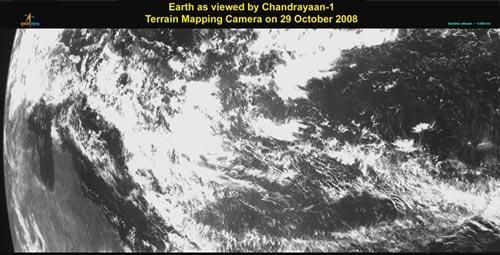Friday, September 10, 2010
China to launch next lunar space mission
Friday, September 25, 2009
Monday, June 22, 2009
NASA Scientists Bring Light to Moon's Permanently Dark Craters

A new lunar topography map with the highest resolution of the moon's rugged south polar region provides new information on some of our natural satellite's darkest inhabitants – permanently shadowed craters. The map was created by scientists at NASA's Jet Propulsion Laboratory, Pasadena, Calif., who collected the data using the Deep Space Network's Goldstone Solar System Radar located in California's Mojave Desert.
Wednesday, November 26, 2008
LASER Instrument on Chandrayaan-1 Successfully Turned ON
Friday, November 7, 2008
Chandrayaan-1: first images

It was another proud moment for the country. Prime Minister Manmohan Singh was shown the first pictures that were taken by Chandrayaan-1 through the Terrain Mapping Camera on Friday.The TMC was operated in October through a series of commands, which were issued from the Spacecraft Control Centre of the Indian Space Research Organisation Telemetry, Tracking and Command Network in Bengaluru.The first images, which were received by the Indian Deep Space Network at Byalalu was later processed by the Indian Space Science Data Centre. The first images were taken at 8 am from a height of 9,000 km.The Terrain Mapping camera (TMC) on board Chandrayaan-1 spacecraft was successfully operated on October 29, 2008 through a series of commands issued from the Spacecraft Control Centre of ISRO Telemetry, Tracking and Command Network (ISTRAC) at Bangalore.
Analysis of the first imagery received by the Indian Deep Space Network (IDSN) at Byalalu and later processed by Indian Space Science Data Centre (ISSDC) confirms excellent performance of the camera.The first imagery (image 1) taken at 8:00 am IST from a height of 9,000 km shows the Northern coast of Australia while the other (image 2) taken at 12:30 pm from a height of 70,000 km shows Australia’s Southern Coast.
TMC is one of the eleven scientific instruments (payloads) of Chandrayaan-1. The camera can take black and white pictures of an object by recording the visible light reflected from it. The instrument has a resolution of about 5 metres.
Links: ISRO
Wednesday, October 22, 2008
India on the moon: Chandrayaan-1 successful

Chandrayaan-1, India’s maiden moon spacecraft, was put into Transfer Orbit around the earth by the Polar Launch Vehicle PSLV-C11 after it blasted off from the Satish Dhawan Space Centre.
The 1,380 kg Chandrayaan-1, carrying 11 payloads, was released into a Transfer Orbit 18.2 minutes after the PSLV-C11 blasted off.

